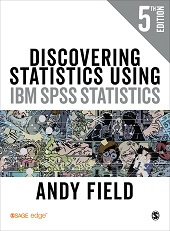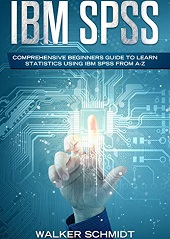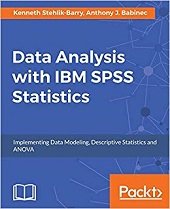This post may contain affiliate links. For more information visit our disclosure page
Reading books is essential in learning anything and the same holds when it comes to learning IBM SPSS Statistics. But learning SPSS can be a hassle with so few free tutorials online. Thankfully books are always a safe bet, and in this post I’ll share my pick for the top 10 best SPSS books you can get.
SPSS Statistics is a software package used for logical batched and non-batched statistical analysis. Analytical tools such as SPSS can readily provide even a novice user with an overwhelming amount of information and a broad range of options for analyzing patterns in the data.
Best SPSS Books To Learn IBM SPSS
The books we listed here are suitable for beginners, intermediate learners as well as experts. Many professionals have already benefited from this compilation, hope you do too!
- Our #1 Choice: Discovering Statistics Using IBM SPSS Statistics
- Best Value Pick: IBM SPSS Statistics 26 Step by Step
- Best Budget Pick: SPSS Survival Manual: A Step by Step Guide to Data Analysis Using IBM SPSS
1. Discovering Statistics Using IBM SPSS Statistics

The Fifth Edition takes students from initial theory through to regression, factor analysis and multilevel modelling, Andy Field animates statistics and SPSS software with his famously bizarre examples and activities.
What’s inside in this new book: A radical new design with original illustrations and even more colour. A maths diagnostic tool to help students establish what areas they need to revise and improve on. A revamped online resource that uses video, case studies, datasets, testbanks and more to help students negotiate project work, master data management techniques, and apply key writing and employability skills. New sections on replication, open science and Bayesian thinking Now fully up to date with latest versions of IBM SPSS Statistics.
Many of the examples in this book, inspired by some of the craziness that you find in the real world, are designed to reflect topics that play on the minds of the average student (i.e. sex, drugs, rock and roll, celebrity, people doing crazy stuff)
2. IBM SPSS: Comprehensive Beginners Guide to Learn Statistics using IBM SPSS from A-Z

As one can tell, information on the whole comes at us from every direction. Its influence on business, politics, and government, banking, the STEM fields, and even the social sciences cannot be understated. But its journey begins with raw data being compiled by means of an experiment or study.
In saying that, this audiobook should serve as a reference guide for those who wish to go beyond the basics into territory that requires a solid understanding of advanced statistical concepts. Still, as a beginner, it will be wise to move forward with care so that you solidify your understanding before you begin to use these advanced methods.
3. IBM SPSS Statistics 26 Step by Step: A Simple Guide and Reference
IBM SPSS Statistics 26 Step by Step, takes a straightforward, step-by-step approach that makes SPSS software clear to beginners and experienced researchers alike.
Extensive use of four-color screen shots, clear writing, and step-by-step boxes guide readers through the program. Exercises at the end of each chapter support students by providing additional opportunities to practice using SPSS.
This book covers both the basics of descriptive statistical analysis using SPSS through to more advanced topics such as multiple regression, multidimensional scaling and MANOVA, including instructions for Windows and Mac. This makes it ideal for both undergraduate statistics courses and for postgraduates looking to further develop their statistics and SPSS knowledge.
4. SPSS for Introductory and Intermediate Statistics: IBM SPSS for Intermediate Statistics

The book reviews research designs and how to assess the accuracy and reliability of data; how to determine whether data meet the assumptions of statistical tests; how to calculate and interpret effect sizes for intermediate statistics, including odds ratios for logistic analysis; how to compute and interpret post-hoc power; and an overview of basic statistics for those who need a review.
Unique chapters on multilevel linear modeling; multivariate analysis of variance (MANOVA); assessing reliability of data; multiple imputation; mediation, moderation, and canonical correlation; and factor analysis are provided. SPSS syntax with output is included for those who prefer this format.
5. How to Use SPSS
How to Use SPSS is designed with the novice computer user in mind and for people who have no previous experience of using SPSS. Each chapter is divided into short sections that describe the statistic being used, important underlying assumptions, and how to interpret the results and express them in a research report.
The book begins with the basics, such as starting SPSS, defining variables, and entering and saving data. It covers all major statistical techniques typically taught in beginning statistics classes, such as descriptive statistics, graphing data, prediction and association, parametric inferential statistics, nonparametric inferential statistics and statistics for test construction.
More than 250 screenshots (including sample output) throughout the book show students exactly what to expect as they follow along using SPSS. The book includes a glossary of statistical terms and practice exercises.
6. SPSS Survival Manual: A Step by Step Guide to Data Analysis Using IBM SPSS
The SPSS Survival Manual throws a lifeline to students and researchers grappling with this powerful data analysis software. It covers new SPSS tools for generating graphs and non-parametric statistics, importing data, and calculating dates.
Author guides you through the entire research process, helping you choose the right data analysis technique for your project. From the formulation of research questions, to the design of the study and analysis of data, to reporting the results, Julie discusses basic and advanced statistical techniques.
She outlines each technique clearly, with step-by-step procedures for performing the analysis, a detailed guide to interpreting data output and an example of how to present the results in a report.
For both beginners and experienced users in psychology, sociology, health sciences, medicine, education, business and related disciplines, the SPSS Survival Manual is an essential text.
>>Also Check: Best IBM SPSS Modeler Books
7. Data Analysis with IBM SPSS Statistics: Implementing data modeling, descriptive statistics and ANOVA

By the end of this book, you will have a firm understanding of the various statistical analysis techniques offered by SPSS Statistics, and be able to master its use for data analysis with ease.
What You Will Learn:
- Install and set up SPSS to create a working environment for analytics
- Techniques for exploring data visually and statistically, assessing data quality and addressing issues related to missing data
- How to import different kinds of data and work with it
- Discover basic relationships among data elements (bivariate data patterns, differences in means, correlations)
- Explore multivariate relationships
- Leverage the offerings to draw accurate insights from your research, and benefit your decision-making
- Organize data for analytical purposes (create new data elements, sampling, weighting, subsetting, and restructure your data)
8. Adventures in Social Research: Data Analysis Using IBM SPSS Statistics

Organized to parallel most introductory research methods texts, this text starts with an introduction to computerized data analysis and the social research process, then takes readers step-by-step through univariate, bivariate, and multivariate analysis using SPSS Statistics.
The range of topics, from beginning to advanced, make Adventures in Social Research appropriate for both undergraduate and graduate courses.
9. Student Study Guide With IBM SPSS Workbook for Essential Statistics for the Behavioral Sciences

To help students practice skills, the guide offers word searches and crossword puzzles for each chapter, extensive practice quizzes linked to chapter learning objectives, and “SPSS in Focus” exercises which complement those in the book.
10. Multilevel and Longitudinal Modeling with IBM SPSS

This book demonstrates how to use multilevel and longitudinal modeling techniques available in the IBM SPSS mixed-effects program (MIXED). Annotated screen shots provide readers with a step-by-step understanding of each technique and navigating the program.
Readers learn how to set up, run, and interpret a variety of models. Diagnostic tools, data management issues, and related graphics are introduced throughout. Annotated syntax is also available for those who prefer this approach. Extended examples illustrate the logic of model development to show readers the rationale of the research questions and the steps around which the analyses are structured.






